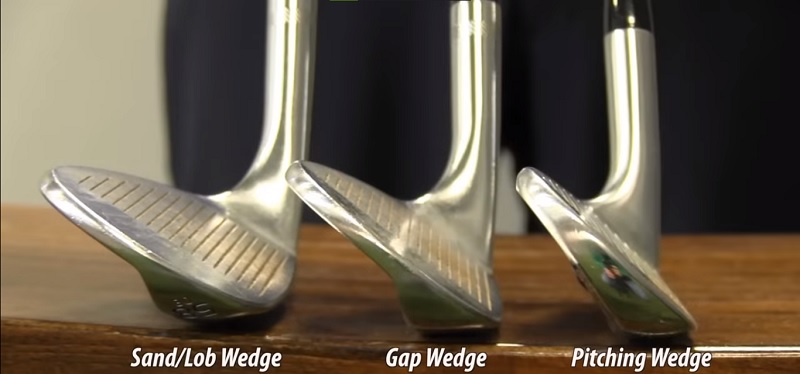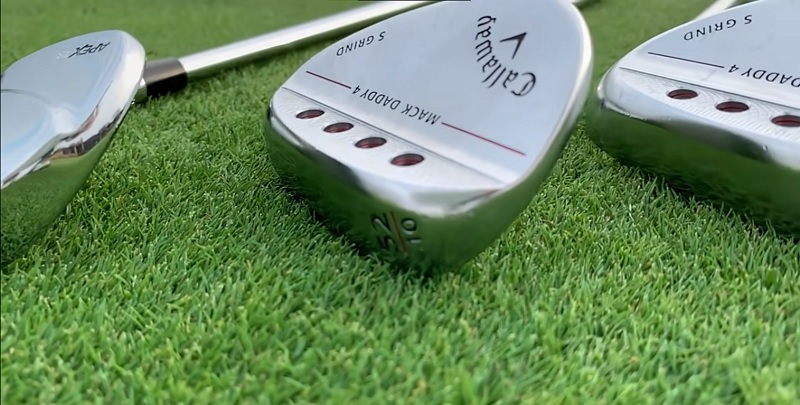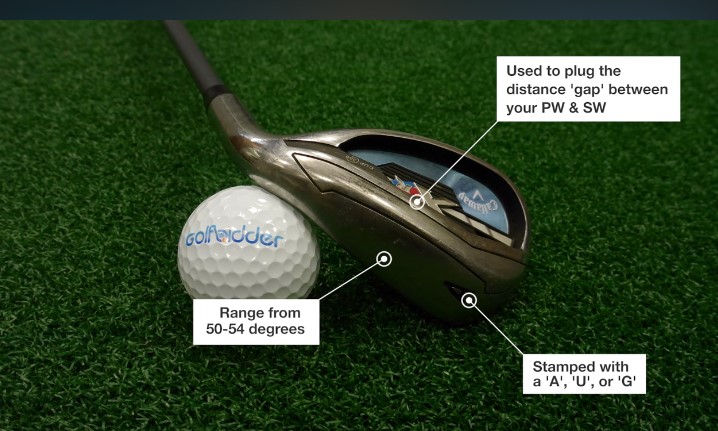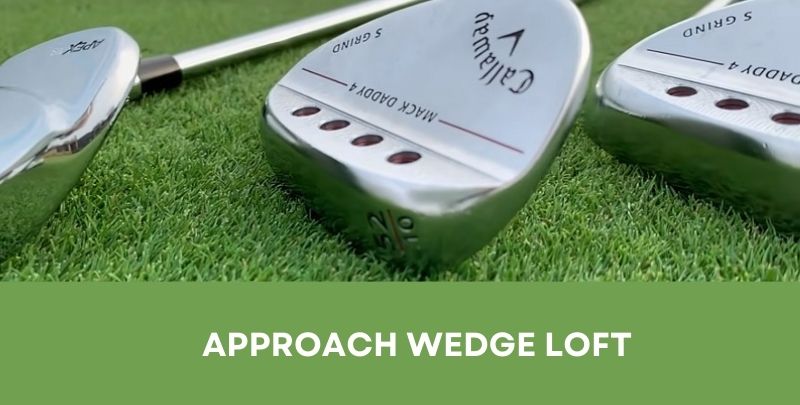You get annoyed and confused to choose between your Pitching Wedge or Sand Wedge to hit 100 yards, which is unsuitable for this distance. There is an additional club but important in the golfer’s iron sets to help fill the gap between Pitching and Sand Wedge. The Approach Wedge, with a loft of around 46 – 52 degrees, improves and optimizes the hit of the golf ball.
This article will discuss the Approach Wedge, especially its loft, who should use it, and when we will use it for the best performance. Let’s dive right in!
What Is The Approach Wedge?
The Approach Wedge (A-Wedge) or the Gap Wedge is a versatile golf club that fills the gap between the pitching and sand wedge. It typically has a loft of around 46 – 52 degrees, with 50 – 52 degrees being the most common. This club is often used to approach the green with precision and control.

The approach wedge supports the pitching wedge and the sand wedge. The gap between the pitching and the sand wedge makes when hitting is around 70 – 100 degrees; that is too far.
If golfers use one of the two for the distance between this gap, it’s not that optimized.
Instead of grappling with the expansive 70-100 degree gap, smart golfers opt for this specialized club. Consequently, manufacturers have introduced this innovative addition to eradicating golfer’s indecisiveness regarding club selection.
The approach wedge showcases its prowess by effortlessly covering distances of approximately 80-100 yards. Additionally, it shines when faced with challenging longer bunker shots, providing superior control and precision compared to the sand wedge.
Exploring More The Approach Wedge Loft

The increased angle of the Gap Wedge allows the golfer to hit the ball with greater accuracy and control when approaching from moderated farther distances.
The approach wedge also provides more spin, which helps to stop the ball quickly once it lands on the green. It is an essential part of any golfer’s short game and is often described as the ‘secret weapon’ for golfers.
The loft angle on the approach wedge will usually range from 48-52 degrees, which can vary depending on the player’s preference and the manufacturers. For example, the loft of the Approach Wedge of Wilson D9 is 47 degrees, while the loft of the PING G425 is 49.5 degrees.
This larger degree of the loft allows for higher levels of backspin, translating into better accuracy and increased stopping power. With this club in their arsenal, golfers can easily land a ball on the green from distances as far away as 100 yards.
This incredibly versatile club can help golfers become more consistent with their shots and improve their overall game.
How Does Approach Wedge Loft Impact Your Game?
The loft of a golf wedge is an important factor that determines the trajectory and distance of the ball. Different wedges have varying degrees of loft, allowing golfers to execute different types of shots.

An approach wedge/gap wedge, typically included in a set of irons, commonly has a loft of around 50 to 52 degrees. For game-improvement irons aimed at beginner and high-handicap golfers, the loft of their approach wedges is often stronger, with as little as 48 degrees.
In contrast, bladed iron sets usually stop at a pitching wedge, while iron sets made for mid to high-handicap golfers often include options for gap wedges or approach wedges.
Given the loft angle of the approach wedge, it is much more efficient in stopping the ball when compared to other clubs. The higher backspin means that the ball will land quickly and accurately on the green.
This feature makes it perfect for those longer bunker shots or for approaching from moderate distances. For example, if you are playing a par 3 and need to hit over a water hazard, the approach wedge can help you achieve this.
Furthermore, it adds an extra layer of control to your shot. As the ball will land more quickly than with other clubs, it gives golfers better accuracy and precision when they are trying to hit a precise spot on the green.
As well as helping improve short-game performance, the approach wedge can also be used for different kinds of shots. For example, it can be used for flop shots, low-pitch shots and even some chips.
Should You Need an Approach Wedge?

Now, you know that Gap Wedge is like a supportive and additional tool for the pitching and sand wedge. But not all of the Gap Wedge has the same loft; that said, it depends on what golfs you are having and what their loft is.
If the distance between the pitching and the sand wedge is too far, around 70 – 110 yards, the Approach Wedge will definitely be the best assistant to help you adjust your club and get the best distance.
However, when you are using 2 golf clubs with their golf lofts diverging about 4 – 6 degrees, they can cover the distance when you hit the full swing. In contrast, if the lofts are too different, you should need an A-Wedge.
Besides, the Approach Wedge serves as a valuable club for golfers seeking enhanced versatility and control in their game.
While the Pitching Wedge is commonly included in iron sets made for mid to high-handicap golfers, the Approach Wedge offers even more precision and adaptability around the greens.
With a loft similar to that of an 11-iron, the Approach Wedge allows players to execute shots with accuracy and finesse, making it a preferred choice for golfers looking to improve their short-game performance.
In addition, the Approach Wedge is especially beneficial for golfers who frequently encounter unique situations near the green. Unlike Sand Wedges and Lob Wedges, which are typically utilized for shorter specialty shots, the Approach Wedge provides a versatile option that can be effectively employed in a variety of scenarios.
Whether it’s a delicate chip from the rough or a controlled pitch over an obstacle, the Approach Wedge offers golfers the confidence and control needed to navigate challenging situations and ultimately enhance their overall performance on the course.
Choosing a Gap Wedge
Selecting the right approach wedge is essential. In addition to ensuring that it fits well with your current set of clubs, consider factors such as the loft angle and bounce. Making sure that the difference of your club’s lofts has a vacant place for the approach wedge, such as 70 – 110 or 80 – 110 degrees.
Moreover, pay attention to the shaft type and flexibility. Soft shafts provide more feedback but are harder to control, while stiffer shafts allow for extra power and distance but may not provide as much feedback.
It’s important to make sure that you’re comfortable with the club in your hands before committing to a purchase. Test out different models until you find one that feels like an extension of your body when you swing it.
And a small thing that may confuse you when choosing the best Gap Wedge is its name and abbreviations. That’s why we list here some of the common abbreviations different manufacturers use.
Right here, this part is for you!
Many names of Approach Wedge Depend On The Manufacturers
The most popular name is Approach Wedge or Gap Wedge. Besides, it can be called an attack wedge, A-wedge…and others such as this list:
- AW
- G
- GW
- U
- UW
- Utility Wedge
- 50°
- 52°
FAQs
What Is The Approach Wedge Used For?
An Approach Wedge is typically included in a set of irons and has a loft of around 50 to 52 degrees. It is used for hitting shots with a distance of around 90 – 100 degrees, and the Pitching or Sand Wedge is not suitable.
What Is The Difference Between A Gap Wedge And Pitching Wedge?
The main difference between a Gap Wedge and Pitching Wedge is the loft. A Gap Wedge typically has a loft of between 50 to 52 degrees, while a Pitching Wedge has a loft of around 48 degrees. The higher loft of the Gap Wedge allows for more accuracy when shooting from long distances.
Is There A Big Difference Between A 50 And 52-degree Wedge?
Though it has a difference but not too big. The higher loft, the higher spin, and the shorter distance. Depending on the purpose and other golf clubs in your bag, you should choose the 50 degrees wedge if you want to have more distance and vice versa.
What Is The Best Approach Wedge?
The best Approach Wedge is the one that fits your set of clubs, as well as your personal preferences. However, some popular models include the TaylorMade ATV Wedge, Callaway Mack Daddy 4 Wedge, and Nike VR Pro Wedge. Ultimately, it’s important to try out different wedges so that you can find the one that works best for you.
Conclusion
The Approach Wedge is a versatile and valuable tool for any golfer looking to improve their game performance. With its increased loft angle, it can help you hit the ball more accurately from moderate distances and provide more control on the green. When selecting an approach wedge, consider factors such as the loft angle, bounce, shaft type, and flexibility to ensure that you find the best fit for your game.
Also, it is important to consider the current set of clubs you have when selecting an Approach Wedge so that it fits in with the rest of your equipment. With a bit of practice and perseverance, you can begin to see improvement in your overall performance on the course.


